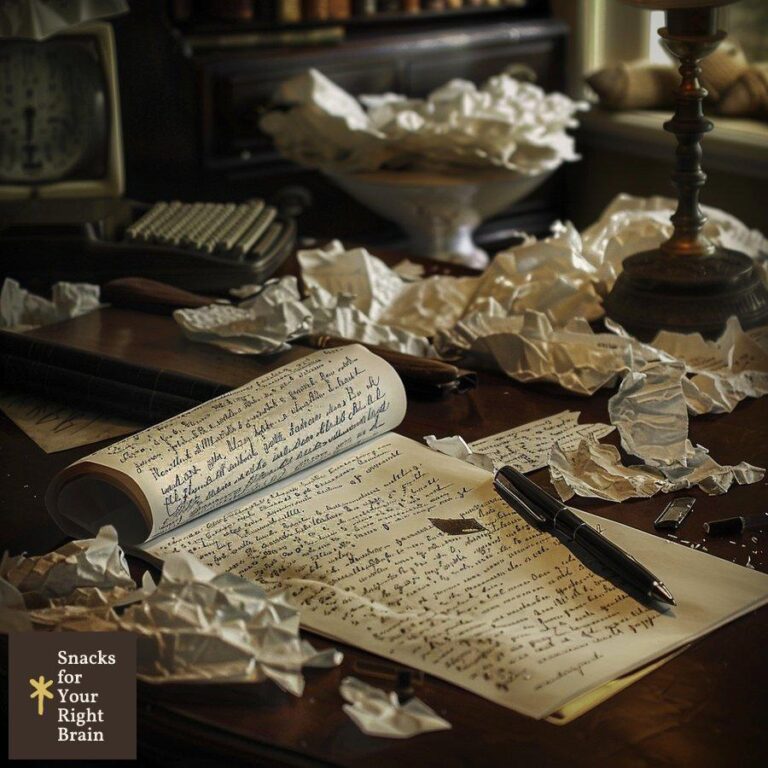How to Write an Opening Scene for a Short Story
Why is a Strong Opening Scene Important?
The opening scene of a short story is the reader’s first impression of your writing. It sets the tone, introduces the characters and conflict, and hooks the reader, compelling them to continue reading. A strong opening scene is crucial for several reasons:
-
Grabs the reader’s attention: A captivating opening scene immediately engages the reader and makes them invested in the story. It leaves them curious and eager to discover what happens next.

-
Establishes the story’s world: The opening scene establishes the setting, time period, and atmosphere of the story. It paints a vivid picture in the reader’s mind and immerses them in the narrative.
-
Introduces the protagonist: The opening scene introduces the main character and gives the reader a glimpse into their personality, goals, and struggles. It allows the reader to connect with the protagonist and empathize with their journey.
-
Hints at the central conflict: The opening scene should hint at the central conflict or problem that the protagonist will face throughout the story. It creates a sense of tension and anticipation, making the reader want to know more.
-
Sets the tone and style: The opening scene sets the tone and style for the rest of the story. It gives the reader an idea of the genre, mood, and writing style they can expect.
A strong opening scene is essential for capturing the reader’s attention and keeping them engaged throughout the story. It lays the foundation for the rest of the narrative and sets the stage for the protagonist’s journey.
What Are the Key Elements of an Effective Opening Scene?

An effective opening scene should include several key elements to hook the reader and set the stage for the story:
1. Engaging hook
The opening line or paragraph should grab the reader’s attention and make them want to keep reading. It can be a surprising statement, a vivid description, or a question that intrigues the reader. The hook should be relevant to the story and hint at the central conflict or theme.
2. Compelling protagonist
The protagonist should be introduced in the opening scene, and the reader should be given a reason to care about them. The protagonist’s goals, struggles, and personality should be hinted at, making the reader invested in their journey.
3. Intriguing conflict
The opening scene should hint at the central conflict or problem that the protagonist will face throughout the story. It should create a sense of tension and anticipation, making the reader want to know more about the stakes and obstacles the protagonist will encounter.
4. Vivid setting
The opening scene should establish the setting of the story, painting a vivid picture in the reader’s mind. The setting should be relevant to the story and contribute to the overall mood and atmosphere.
5. Distinctive voice
The opening scene should establish the story’s voice and style. The writing should be engaging, distinctive, and consistent with the tone and genre of the story.
By incorporating these key elements, an opening scene can effectively hook the reader and set the stage for a compelling short story.
How Can You Write a Captivating Opening?

Writing a captivating opening scene requires careful planning and execution. Here are some tips to help you craft an engaging beginning to your short story:
1. Start in medias res
Begin your story in the middle of the action or a significant moment. This technique, known as in medias res, immediately engages the reader and creates a sense of urgency. It also allows you to introduce the protagonist and conflict without lengthy exposition.
2. Use sensory details
Incorporate vivid sensory details to paint a picture in the reader’s mind. Describe the sights, sounds, smells, tastes, and textures of the setting to immerse the reader in the story world. Use specific and evocative language to create a strong impression.
3. Reveal character through action
Instead of telling the reader about your protagonist’s personality, reveal it through their actions and dialogue. Show how they react to their circumstances and interact with other characters to give the reader a sense of who they are.
4. Foreshadow the central conflict
Hint at the central conflict or problem that the protagonist will face throughout the story. Use subtle clues, dialogue, or descriptions to create a sense of tension and anticipation. This will make the reader curious about the stakes and obstacles the protagonist will encounter.
5. Establish a distinctive voice
Develop a unique and engaging voice for your story. Use specific language, sentence structures, and narrative techniques to create a distinctive style that sets your story apart. The voice should be consistent with the tone and genre of the story and should draw the reader in.
By following these tips and incorporating the key elements of an effective opening scene, you can write a captivating beginning that hooks the reader and sets the stage for a compelling short story.
What Common Pitfalls Should You Avoid?
When writing an opening scene, there are several common pitfalls to avoid:
-
Lengthy exposition: Avoid starting your story with lengthy background information or descriptions. Instead, incorporate necessary details gradually throughout the story.
-
Clichéd openings: Steer clear of overused openings, such as waking up, looking in the mirror, or starting with dialogue. These can feel unoriginal and fail to engage the reader.
-
Confusing or unclear writing: Make sure your opening scene is clear and easy to follow. Avoid using too many characters, locations, or plot points at once, as this can overwhelm the reader.
-
Lack of tension or conflict: Without a sense of tension or conflict, the reader may lose interest. Make sure your opening scene hints at the central problem or obstacle the protagonist will face.
-
Inconsistent voice: Maintain a consistent and distinctive voice throughout your opening scene. Avoid switching between different styles or tones, as this can be jarring for the reader.
By being aware of these common pitfalls and avoiding them in your writing, you can craft a strong and engaging opening scene that sets the stage for a compelling short story.
Which Examples of Memorable Opening Scenes Can Inspire You?
Many classic and contemporary short stories feature memorable opening scenes that hook the reader and set the tone for the story. Here are a few examples that can inspire your own writing:
- “The Lottery” by Shirley Jackson
“The morning of June 27th was clear and sunny, with the fresh warmth of a full-summer day; the flowers were blossoming profusely and the grass was richly green.”
This opening scene sets the stage for a story that takes a dark and unsettling turn. The contrast between the idyllic setting and the sinister events that follow creates a sense of unease and anticipation.
- “Hills Like White Elephants” by Ernest Hemingway
“The hills across the valley of the Ebro were long and white. On this side there was no shade and no trees and the station was between two lines of rails in the sun.”
Hemingway’s minimalist style is on full display in this opening scene, which establishes the setting and hints at the underlying tension between the two characters. The sparse language and lack of exposition draw the reader in and make them curious about the characters and their relationship.
- “The Lottery Rose” by Irene Hunt
“Georgie Burgess was a small boy, smaller than most of the other boys in his class at school. He was thin and pale, with a shock of unruly black hair that fell over his forehead and into his eyes.”
This opening scene introduces the protagonist, Georgie, and establishes his physical appearance and social status. It also hints at the challenges he faces, setting the stage for his journey of self-discovery and growth.
- “The Ones Who Walk Away from Omelas” by Ursula K. Le Guin
“With a clamor of bells that set the swallows soaring, the Festival of Summer came to the city Omelas, bright-towered by the sea.”
Le Guin’s opening scene paints a vivid picture of a utopian city celebrating a joyous festival. However, the story takes a dark turn as the narrator reveals a disturbing secret at the heart of Omelas. This contrast creates a sense of unease and makes the reader question the nature of happiness and morality.
These examples demonstrate how a strong opening scene can hook the reader, establish the tone and style of the story, and set the stage for the events that follow. By studying and analyzing these openings, you can gain inspiration for crafting your own memorable beginning.
How Can You Revise and Refine Your Opening Scene?
Once you have written your opening scene, it’s important to revise and refine it to ensure that it effectively hooks the reader and sets the stage for the rest of the story. Here are some tips for revising your opening scene:
1. Read it aloud
Reading your opening scene aloud can help you identify areas that need improvement. Listen for awkward phrasing, repetitive language, and areas where the flow of the story is disrupted.

2. Check for clarity
Make sure your opening scene is clear and easy to follow. Avoid using too many characters, locations, or plot points at once, as this can overwhelm the reader. Use specific and evocative language to paint a vivid picture in the reader’s mind.
3. Eliminate unnecessary details
Look for areas where you can cut unnecessary details or exposition. Stick to the most important information needed to hook the reader and set the stage for the story.
4. Enhance the hook
Evaluate the strength of your opening hook. Does it grab the reader’s attention and make them want to keep reading? Consider revising the first line or paragraph to create a more compelling hook.
5. Foreshadow the central conflict
Make sure your opening scene hints at the central conflict or problem that the protagonist will face throughout the story. Use subtle clues, dialogue, or descriptions to create a sense of tension and anticipation.
6. Establish a distinctive voice
Ensure that your opening scene maintains a consistent and distinctive voice. Use specific language, sentence structures, and narrative techniques to create a style that sets your story apart.
7. Get feedback
Share your opening scene with others and ask for feedback. What did they find compelling or confusing? What questions did they have about the story? Use this feedback to identify areas that need further revision.
By following these tips and revising your opening scene, you can craft a compelling beginning that hooks the reader and sets the stage for a memorable short story.





